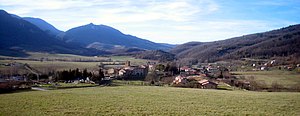Bugarach
| Bugarach | ||
|---|---|---|

|
|
|
| region | Occitania | |
| Department | Aude | |
| Arrondissement | Limoux | |
| Canton | La Haute-Vallée de l'Aude | |
| Community association | Limouxin | |
| Coordinates | 42 ° 53 ′ N , 2 ° 21 ′ E | |
| height | 340-1,231 m | |
| surface | 26.62 km 2 | |
| Residents | 228 (January 1, 2017) | |
| Population density | 9 inhabitants / km 2 | |
| Post Code | 11190 | |
| INSEE code | 11055 | |
| Website | www.bugarach.fr | |
 Bugarach - town view |
||
Bugarach is a French town and municipality with 228 inhabitants (as of January 1, 2017) in the south of the Aude department in the Occitania region .
Location and climate
The place is located in the headwaters of the Blanque river , a tributary of the Sals , approx. 31 km (driving distance) southeast of Limoux at an altitude of approx. 490 m at the foot of the Pic de Bugarach . The climate is temperate to mild; Rain (approx. 790 mm / year) falls mainly in the winter half-year.
Population development
| year | 1800 | 1851 | 1901 | 1954 | 1999 | 2016 | ||
| Residents | 732 | 780 | 506 | 226 | 176 | 224 | ||
| Source: Cassini and INSEE | ||||||||
The population decline, which began in the 19th century, continued into the 1970s of the 20th century; it is essentially related to the phylloxera crisis in viticulture, the mechanization of agriculture and the abandonment of small farms. The renewed increase in population since the 1980s is mainly due to tourism, because according to supporters of a theory that according to the Mayan calendar the world would end on December 21, 2012, Bugarach would have been the only place to survive the apocalypse. Already in the summer of 2011, most of the tourists in the place were esoteric. However, feared dramatic events, such as mass suicides, did not take place.
economy
During the reign of Louis XV. Men from Bugarach also had to fight in the Seven Years' War (1756–1763). Many of them came as prisoners to Upper Silesia, where they learned the craft of herding, a skill that they brought back to their homeland after the end of their captivity. In its heyday, the village had over 1,000 inhabitants in 1831. After that, however, many residents moved away from Bugarach and the agricultural character remained.
The place and its surrounding area are still largely agriculturally oriented, although the need and the will for self-sufficiency after the improvement of the infrastructure in the second half of the 20th century hardly exist today. The place has turned into a wine place; the wines produced here may be marketed under various appellations . In addition, numerous holiday apartments ( gîtes ) are rented out.
history
The first evidence of the existence of a villa comes from the 9th century. Later the place appears in several documents; the Albigensian Wars (1209–1229) passed him by. During the Huguenot Wars (1562–1598), the Protestant town, its castle and its inhabitants were badly affected. In the 18th century, numerous soldiers were raised here for the Seven Years' War. After the Second World War, a large part of the remaining inhabitants left the small town and moved to the cities; in 1975 only 125 inhabitants were counted. It was not until the end of the 1960s with the arrival of alternative farmers that the town was revitalized. From 2000, esotericists began to be interested in Bugarach. Today most of the residents are newcomers and the economy is geared towards tourism.
Culture and sights
- The approx. 1230 m high Pic de Bugarach towers over the place and is visible from almost everywhere.
- The castle (château) of Bugarach essentially dates from the early 16th century, but it was largely destroyed during the Huguenot Wars.
- The single-aisled Église de Notre Dame de l'Assomption is dedicated to the Assumption of Mary . It essentially comes from the 17th century, ie the time after the end of the wars of religion.
- Surroundings
- A single arch bridge (Pont Romain) possibly dating back to Roman times crosses a ravine of the Blanque river near the village. It was restored in 1993.
Web links
Individual evidence
- ↑ Bugarach - climate tables
- ↑ No apocalypse in a small village. In: orf.at. May 19, 2011, archived from the original on August 26, 2011 ; Retrieved August 26, 2011 .
- ↑ The Invasion of the Esoteric. In: Süddeutsche Zeitung. June 16, 2011, accessed December 21, 2012 .
- ^ Bugarach - Viticulture
- ↑ Bugarach - History
- ↑ Bugarach - Castle
- ↑ Bugarach - Castle
- ↑ Bugarach - Roman Bridge

